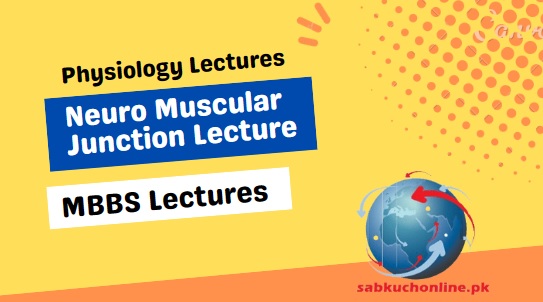LEARNING OBJECTIVES
At the end of the session, the students should be able to:
• Describe the physiological anatomy of Neuromuscular Junction.
• Describe the process of secretion of acetylcholine from nerve terminals.
• Discuss the motor unit.
• Explain the events at a neuromuscular junction.
Review of previous lecture
Functions of Muscles
Types of Muscles
Functional anatomy of skeletal muscles
Sarcomere
Introduction to NMJ
Neuromuscular Junction
•NEUROMUSCULAR JUNCTION
•or
•MYONEURAL JUNCTION

-Neuromuscular Junction
-Synapse
•Axon Terminal
•Terminal Button
•Synaptic cleft
•Synaptic trough
•Motor end plate
•Subneural clefts



Motor Unit
One motor neuron innervates a number of muscle fibers, but each muscle fiber is supplied by only one motor neuron.
When a motor neuron is activated, all the muscle fibers it supplies are stimulated to contract simultaneously.
This team of concurrently activated components—one motor neuron plus all the muscle fibers it innervates—is called a motor unit.



Acetylcholine Receptors
•Acetylcholine-gated ion channels
•Molecular weight -275,000
•Two alpha, one each of beta, delta, and gamma /epsilon
•Two acetylcholine molecules attach to the two alpha subunits, opens the channel
Activation of Acetylcholine-gated ion channels


End Plate Potential
•Opening the acetylcholine-gated channels allows large numbers of sodium ions to pour to the inside of the fiber
•Sodium ions carry with them large numbers of positive charges
•Creates a local positive potential change inside the muscle fiber membrane, called the end plate potential.
•End plate potential initiates an action potential that spreads along the muscle membrane
Events at Neuro-Muscular Junction
1.Propagation of an action potential to a terminal button of motor neuron.
Events of Neuromuscular Junction
1.Propagation of an action potential to a terminal button of motor neuron.
2.Opening of voltage-gated Ca2+channels.
1.Propagation of an action potential to a terminal button of motor neuron.
2.Opening of voltage-gated Ca2+channels.
3.Entry of Calcium into the terminal button.
1.Propagation of an action potential to a terminal button of motor neuron.
2.Opening of voltage-gated Ca2+channels.
3.Entry of Calcium into the terminal button.
4.Ca2+activates Ca2+-Calmodulin dependent protein kinases
1.Propagation of an action potential to a terminal button of motor neuron.
2.Opening of voltage-gated Ca2+channels.
3.Entry of Calcium into the terminal button.
4.Ca2+activates Ca2+-Calmodulin dependent protein kinases
5.Phosphorylation of Synapsin protein.
1.Propagation of an action potential to a terminal button of motor neuron.
2.Opening of voltage-gated Ca2+channels.
3.Entry of Calcium into the terminal button.
4.Ca2+activates Ca2+-Calmodulin dependent protein kinases
5.Phosphorylation of Synapsinprotein.
6.Freeing Acetylcholine vesicles to move to active sites.
1.Propagation of an action potential to a terminal button of motor neuron.
2.Opening of voltage-gated Ca2+channels.
3.Entry of Calcium into the terminal button.
4.Ca2+activates Ca2+-Calmodulin dependent protein kinases
5.Phosphorylation of Synapsinprotein.
6.Freeing Acetylcholine vesicles to move to active sites.
7.Vesicles dock and fuse with neural membrane.
1.Propagation of an action potential to a terminal button of motor neuron.
2.Opening of voltage-gated Ca2+channels.
3.Entry of Calcium into the terminal button.
4.Ca2+activates Ca2+-Calmodulin dependent protein kinases
5.Phosphorylation of Synapsinprotein.
6.Freeing Acetylcholine vesicles to move to active sites.
7.Vesicles dock and fuse with neural membrane.
8.Release of acetylcholine (by exocytosis).
1.Propagation of an action potential to a terminal button of motor neuron.
2.Opening of voltage-gated Ca2+channels.
3.Entry of Calcium into the terminal button.
4.Ca2+activates Ca2+-Calmodulin dependent protein kinases
5.Phosphorylation of Synapsinprotein.
6.Freeing Acetylcholine vesicles to move to active sites.
7.Vesicles dock and fuse with neural membrane.
8.Release of acetylcholine (by exocytosis).
9.Diffusion of Acetylcholine across the space.
1.Propagation of an action potential to a terminal button of motor neuron.
2.Opening of voltage-gated Ca2+channels.
3.Entry of Calcium into the terminal button.
4.Ca2+activates Ca2+-Calmodulin dependent protein kinases
5.Phosphorylation of Synapsinprotein.
6.Freeing Acetylcholine vesicles to move to active sites.
7.Vesicles dock and fuse with neural membrane.
8.Release of acetylcholine (by exocytosis).
9.Diffusion of Acetylcholine across the space.
10.Binding of Acetylcholine to Acetylcholine-gated ions channels receptor on motor end plate.
1.Propagation of an action potential to a terminal button of motor neuron.
2.Opening of voltage-gated Ca2+channels.
3.Entry of Calcium into the terminal button.
4.Ca2+activates Ca2+-Calmodulin dependent protein kinases
5.Phosphorylation of Synapsinprotein.
6.Freeing Acetylcholine vesicles to move to active sites.
7.Vesicles dock and fuse with neural membrane.
8.Release of acetylcholine (by exocytosis).
9.Diffusion of Acetylcholine across the space.
10.Binding of Acetylcholine to Acetylcholine-gated ions channels receptor on motor end plate.
11.Infuxof mostly Sodium in to the muscle fiber.
1.Propagation of an action potential to a terminal button of motor neuron.
2.Opening of voltage-gated Ca2+channels.
3.Entry of Calcium into the terminal button.
4.Ca2+activates Ca2+-Calmodulin dependent protein kinases
5.Phosphorylation of Synapsinprotein.
6.Freeing Acetylcholine vesicles to move to active sites.
7.Vesicles dock and fuse with neural membrane.
8.Release of acetylcholine (by exocytosis).
9.Diffusion of Acetylcholine across the space.
10.Binding of Acetylcholine to Acetylcholine-gated ions channels receptor on motor end plate.
11.Infuxof mostly Sodium in to the muscle fiber.
12.Local positive potential change inside muscle fiber, motor end plate potential.
1.Propagation of an action potential to a terminal button of motor neuron.
2.Opening of voltage-gated Ca2+channels.
3.Entry of Calcium into the terminal button.
4.Ca2+activates Ca2+-Calmodulin dependent protein kinases
5.Phosphorylation of Synapsinprotein.
6.Freeing Acetylcholine vesicles to move to active sites.
7.Vesicles dock and fuse with neural membrane.
8.Release of acetylcholine (by exocytosis).
9.Diffusion of Acetylcholine across the space.
10.Binding of Acetylcholine to Acetylcholine-gated ions channels receptor on motor end plate.
11.Infuxof mostly Sodium in to the muscle fiber.
12.Local positive potential change inside muscle fiber, motor end plate potential.
13.Spread of Action Potential along muscle membrane.
